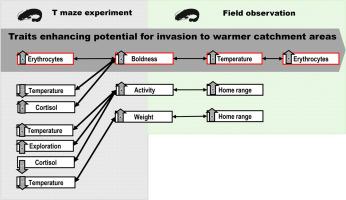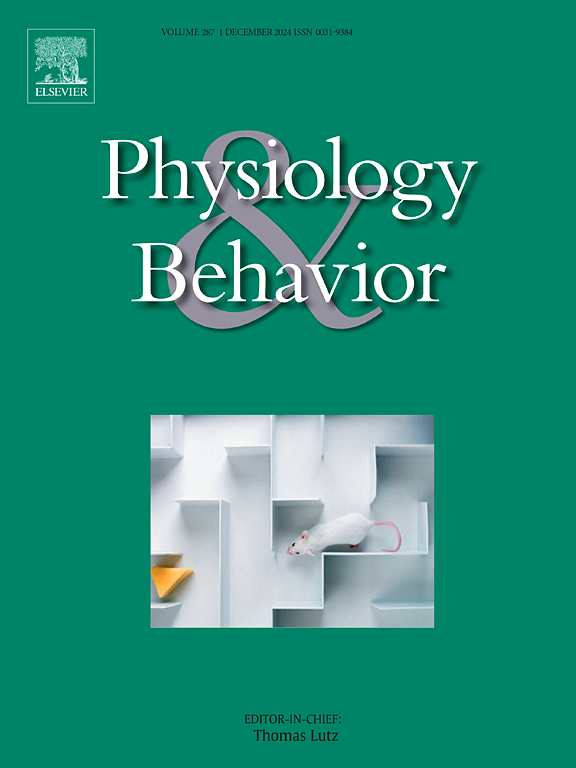与较高的红细胞水平和对较高温度的偏好相关的大胆可以支持欧洲鲶鱼向新的和更温暖的生态系统的传播
IF 2.5
3区 医学
Q2 BEHAVIORAL SCIENCES
引用次数: 0
摘要
应对方式是动物对压力源的一致的生理和行为反应,更一般地说,是对社会和自然环境变化的反应。个体的应对方式可分为主动型和被动型,其行为特征和生理特征各不相同。积极主动,即更大胆、探索和抗压力的个体,更容易传播,更喜欢更高的温度;然而,关于这种自然压力源的可用数据仅来自实验室实验。事实上,关于野生入侵物种特征的数据很少。在这项研究中,我们分析了欧洲鲶鱼的胆度、探索行为、活动、生理参数和温度偏好之间的关系,欧洲鲶鱼是一种破坏自然环境外生态系统稳定的大型入侵物种。正如预期的那样,大胆的个体表现出更高的红细胞计数,更低的基线皮质醇水平,以及更多的探索行为。在河流环境中,大胆的鱼更喜欢温暖的地区,这反映了它们更高的代谢需求和活动水平。大胆、红细胞数量和对高温的偏好是野外和实验环境中的关键特征。然而,参数之间的关系不同,表明对不同环境条件的行为适应性。在我们的研究中,观察到的生理和行为特征倾向于增加欧洲鲶鱼在温暖地区的入侵潜力。本文章由计算机程序翻译,如有差异,请以英文原文为准。

Boldness associated with higher erythrocyte levels and a preference for higher temperatures can support the spread of European catfish to novel and warmer ecosystems
Coping styles are the consistent physiological and behavioural responses of animals to stressors and, more generally, to variability in social and natural environments. Individuals can be characterized as proactive or reactive on the basis of their coping style, and their behavioural and physiological characteristics differ. Proactive, i.e., more bold, exploratory and stress-resistant individuals, spread more easily and prefer higher temperatures; however, available data regarding this natural stressor are available only from laboratory experiments. Indeed, data regarding the characteristics of invasive species in the wild are rare. In this study, we analysed the relationships among the boldness, exploratory behaviour, activity, physiological parameters, and temperature preferences of the European catfish, a large invasive species that destabilizes ecosystems outside its native environment. As expected, bold individuals presented greater erythrocyte counts, lower baseline cortisol levels, and increased exploratory behaviour. In a riverine environment, bold fish preferred warmer zones, reflecting their heightened metabolic demands and increased activity levels. Boldness, the number of erythrocytes and a preference for higher temperatures were key traits in both the field and experimental environments. However, the relationships among the parameters differed, suggesting behavioural adaptability to varying environmental conditions. In our study, the observed physiological and behavioural traits tended to increase the invasive potential of European catfish in warmer regions.
求助全文
通过发布文献求助,成功后即可免费获取论文全文。
去求助
来源期刊

Physiology & Behavior
医学-行为科学
CiteScore
5.70
自引率
3.40%
发文量
274
审稿时长
47 days
期刊介绍:
Physiology & Behavior is aimed at the causal physiological mechanisms of behavior and its modulation by environmental factors. The journal invites original reports in the broad area of behavioral and cognitive neuroscience, in which at least one variable is physiological and the primary emphasis and theoretical context are behavioral. The range of subjects includes behavioral neuroendocrinology, psychoneuroimmunology, learning and memory, ingestion, social behavior, and studies related to the mechanisms of psychopathology. Contemporary reviews and theoretical articles are welcomed and the Editors invite such proposals from interested authors.
 求助内容:
求助内容: 应助结果提醒方式:
应助结果提醒方式:


